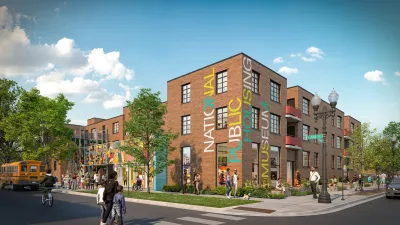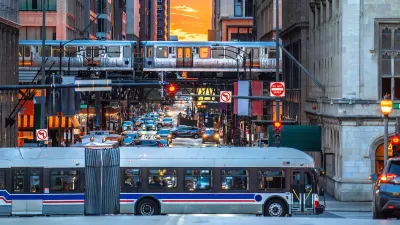Ten years ago, Chicago held a design competition for pedestrian bridges at five locations on the lakefront. As the projects have languished, so has improved access between neighborhoods like North Kenwood and Oakland to nearby Burnham Park.
Chicago Tribune Architecture Critic Blair Kamin checks in on the progress of the 35th Street Bridge, which crosses South Lake Shore Drive on the Southside of Chicago. The current derelict state of the bridge some big questions, according to Kamin: "Who gets what and when do they get it? Who's first in line for infrastructure that improves the quality of life and who has to wait? Are public works equitably distributed or, as D. Bradford Hunt and Jon B. DeVries concluded last year in their insightful book, 'Planning Chicago,' does politics distort planning?"
The slow pace of the $18.3-million project to rebuild the 35th Street Bridge is a conspicuous reminder of how best laid plans at equitable distribution of public works progress can end up proving that last point. "Ten years ago, there was optimism that these problems would be solved when Chicago held a design competition for pedestrian bridges at five lakefront sites, including North Avenue and 35th, 41st and 43rd Streets on the south shoreline. Residents of the mostly African-American North Kenwood and Oakland neighborhoods anticipated better access to nearby Burnham Park. So did developers building townhomes and apartment blocks in the reviving neighborhoods."
The 35th Street Bridge has, at various moments in time, been slated to begin construction in 2006, 2007…and 2009 and 2010….and again in 2013. Now the target date for completion is 2015.
"Meanwhile, it's unclear if the competition-winning designs for the curving pedestrian bridges at 41st and 43rd Street, by Chicago firm Cordogan Clark & Associates, will ever make the leap from renderings to reality. Designs for those spans are still being refined, and Scales said construction will start in the summer of 2015 'if all goes well.' Don't bet the farm on it."
FULL STORY: Pedestrian bridges leave dots unconnected

Study: Maui’s Plan to Convert Vacation Rentals to Long-Term Housing Could Cause Nearly $1 Billion Economic Loss
The plan would reduce visitor accommodation by 25,% resulting in 1,900 jobs lost.

Alabama: Trump Terminates Settlements for Black Communities Harmed By Raw Sewage
Trump deemed the landmark civil rights agreement “illegal DEI and environmental justice policy.”

Why Should We Subsidize Public Transportation?
Many public transit agencies face financial stress due to rising costs, declining fare revenue, and declining subsidies. Transit advocates must provide a strong business case for increasing public transit funding.

Paris Bike Boom Leads to Steep Drop in Air Pollution
The French city’s air quality has improved dramatically in the past 20 years, coinciding with a growth in cycling.

Why Housing Costs More to Build in California Than in Texas
Hard costs like labor and materials combined with ‘soft’ costs such as permitting make building in the San Francisco Bay Area almost three times as costly as in Texas cities.

San Diego County Sees a Rise in Urban Coyotes
San Diego County experiences a rise in urban coyotes, as sightings become prevalent throughout its urban neighbourhoods and surrounding areas.
Urban Design for Planners 1: Software Tools
This six-course series explores essential urban design concepts using open source software and equips planners with the tools they need to participate fully in the urban design process.
Planning for Universal Design
Learn the tools for implementing Universal Design in planning regulations.
Smith Gee Studio
Alamo Area Metropolitan Planning Organization
City of Santa Clarita
Institute for Housing and Urban Development Studies (IHS)
City of Grandview
Harvard GSD Executive Education
Toledo-Lucas County Plan Commissions
Salt Lake City
NYU Wagner Graduate School of Public Service





























